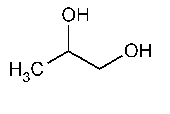Propylene Glycol
»Propylene Glycol contains not less than 99.5percent of C3H8O2.
Packaging and storage—
Preserve in tight containers.
Identification,Infrared Absorption á197Fñ
on undried specimen.
Specific gravity á841ñ:
between 1.035and 1.037.
Acidity—
Add 1mLof phenolphthalein TSto 50mLof water,then add 0.1Nsodium hydroxide until the solution remains pink for 30seconds.Then add 10mLof Propylene Glycol,accurately measured,and titrate with 0.10Nsodium hydroxide until the original pink color returns and remains for 30seconds:not more than 0.20mLof 0.10Nsodium hydroxide is required.
Water,Method Iá921ñ:
not more than 0.2%.
Residue on ignition—
Heat 50g in a tared 100-mLshallow dish until it ignites,and allow it to burn without further application of heat in a place free from drafts.Cool,moisten the residue with 0.5mLof sulfuric acid,and ignite to constant weight:the weight of the residue does not exceed 3.5mg.
Chloride á221ñ—
A1-mLportion shows no more chloride than corresponds to 0.10mLof 0.020Nhydrochloric acid (0.007%).
Sulfate á221ñ—
A5.0-mLportion shows no more sulfate than corresponds to 0.30mLof 0.020Nsulfuric acid (0.006%).
Heavy metals á231ñ—
Mix 4.0mLwith water to make 25mL:the limit is 5ppm.
Organic volatile impurities,Method IVá467ñ:
meets the requirements.
Assay—
Chromatographic system (see Chromatography á621ñ)—
The gas chromatograph is equipped with a thermal conductivity detector,and contains a 1-m ×4-mm column packed with 5%G16on support S5.The injection port temperature is 240 ,the detector temperature is 250
,the detector temperature is 250 ,and the column temperature is programmed at a rate of 5
,and the column temperature is programmed at a rate of 5 per minute from 120
per minute from 120 to 200
to 200 ,and helium is used as the carrier gas.The approximate retention time for propylene glycol is 5.7minutes,and the approximate retention times for the 3isomers of dipropylene glycol,when present,are 8.2,9.0,and 10.2minutes,respectively.
,and helium is used as the carrier gas.The approximate retention time for propylene glycol is 5.7minutes,and the approximate retention times for the 3isomers of dipropylene glycol,when present,are 8.2,9.0,and 10.2minutes,respectively.
Procedure—
Inject a suitable volume,typically about 10µL,of Propylene Glycol into a suitable gas chromatograph,and record the chromatogram.Calculate the percentage of C3H8O2in the Propylene Glycol by dividing the area under the propylene glycol peak by the sum of the areas under all of the peaks,excluding those due to air and water,and multiplying by 100.
Auxiliary Information—
Staff Liaison:Justin Lane,B.S.,Scientific Associate
Expert Committee:(EMC)Excipients:Monograph Content
USP28–NF23Page 1665
Phone Number:1-301-816-8323
